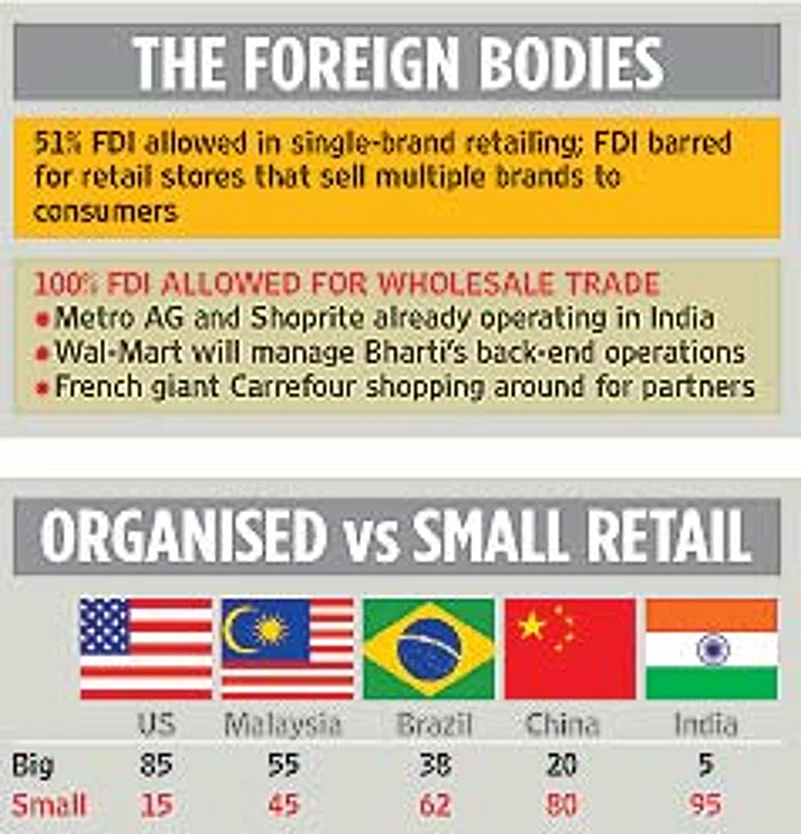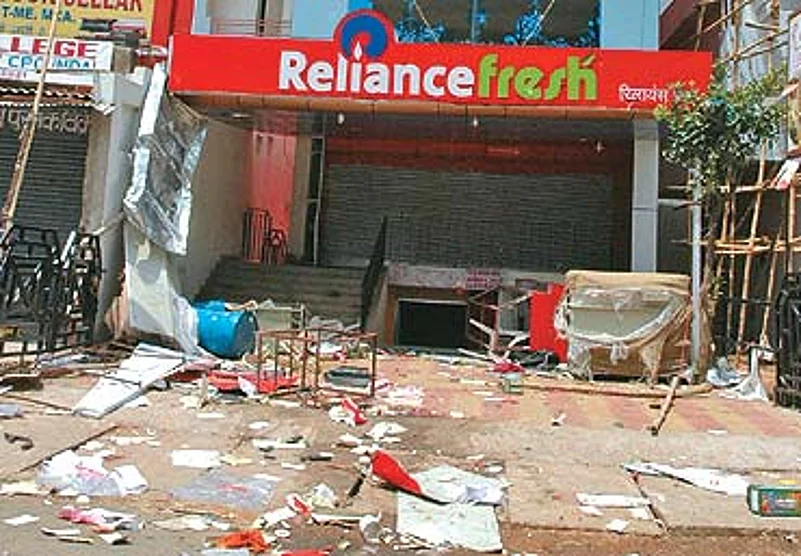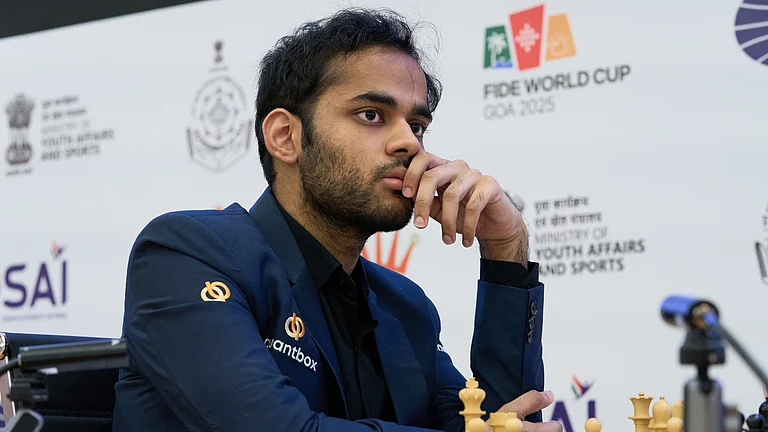The Big Picture
- At $280 billion, India’s retail sector accounts for 10% of GDP and employs 42 million people (8% of the total workforce). Estimated growth: 9.5% annually.
- There are 12 million unorganised retailers (or neighbourhood stores) across the country. Completely fragmented, 80% are family-owned and run.
- Organised, big retail accounts for 4-5% of the total pie. Estimated to grow to $100 bn (16% of total retail) in five years’ time.
- Big retail is just 1% of the food & grocery market
***
Investment of $35 bn in retail over the next five years, largely in food & grocery
- Reliance Retail Planned investment of over $6 bn; has 430 Reliance Fresh stores, targets 1,500 by 2011
- Pantaloon Retail Operates in many retail formats, ambitious plans to grow its 51 Big Bazaar hypermarkets and 77 Food Bazaars
- AV Birla Group Has 299 stores branded ‘More’, plans to double by 2008-end; strong in the South after acquiring Trinethra, aims for a national footprint
- RPG Group Has 350 Spencer’s retail stores in 55 cities in four formats; aims to have 500 stores in 65 cities by March 2008
- Bharti Group With Wal-Mart in charge of backend operations, plans $7 bn investment in creating a retail network in the country, including 100 hypermalls
- Subhiksha Trading Set up a decade ago, its deep-discount chain has 1,070 stores Other players include Godrej (Aadhar, Nature’s Basket), Indiabulls Wholesale (Trumart), Tata Group (Trent) and so on
***
"We get most of our food on credit from our local grocery store. Also, Keshto mama (the grocery store owner) has always been considerate and close to all of us. We can't break that relationship. I did go to Food Bazaar once, but felt lost and like an alien there."
—Pritha Mukherjee, assistant at the Calcutta Municipal Corporation's health department
"I have been coming to Reliance Fresh since it opened and just love the ease of shopping here. Some items are not as cheap as elsewhere, but I don't mind because it is a one-stop shop and I save in fuel costs going from shop to shop."
—K.K. Mahajan, a Chandigarh-based retired government officer whose brother runs a corner store
These two disparate voices from consumers lie at the heart of an emotional debate on the future of the small store in India. Driven by projections that the country will become the world's fifth-largest consumer market in a couple of decades, corporate houses will pump in a huge $35 billion over the next five years to build networks of big retail chains, promising greater choice and savings for consumers, millions of jobs, as well as an overhaul of the way India shops. The impact is already being felt in urban centres as new, branded shop formats come up, seemingly overnight. But as the juggernaut rolls on, so do the questions. Will Indian consumers change their shopping habits? Will deep pockets outprice and outmanoeuvre the existing players? And finally, will the traditional mom-and-pop (or kirana) store survive?
***
"Local grocery stores give you discount on everything. There’s also the personalised service." Ranjana Chowdhury, Lawyer, Indirapuram
"I get stuff from Nilgiris, which offers variety and fresh stock. Choice at small shops is limited; you are never sure of quality." Shalini Vinay, Homemaker, Bangalore
"In a supermarket, the display acts as a reminder of some things you need but don’t have on a list." Shanti Raj, Housewife, Chennai
"I never shopped in markets. But now I go to Spencer’s nearby. It’s so neat andcustomer-friendly." V.K. Mittal, Retired bureaucrat, Lucknow
***
"Companies are now circumspect. While there is no slowdown, they are treading carefully.’’Arvind Singhal Chairman, Technopak
"We have created a new breed of shoppers that does not compete with the daily shopping needs that kirana stores cater to." Kishore Biyani, Chairman, Future Group
"With every new unit opening, business would definitely fall for the existing ones in the short term." R. Subramanian, MD, Subhiksha Trading
"The intermediaries and middlemen of today could become entrepreneurs of a different kind." Rajan Bharti Mittal, MD, Bharti Enterprises
***


***

Then, there are the farmer associations, which say that big retail will lead to cartelisation which in turn will eat into their margins. But farmer bodies—like Namdhari's Fresh—are benefiting, because they realise value in their produce. Minister of state for commerce Jairam Ramesh feels organised retailing has potential: "To the extent that the big retail chains source products from areas like the Northeast, it'll be an advantage. But it remains to be seen whether they will do so." In all, 19 states allow farmers to sell directly to companies instead of going through the mandis, which are asserting themselves. For instance, in Delhi's Azadpur Mandi, companies sourcing directly from farmers have to pay it a 1 per cent tax. The associations have demanded a regulator to govern direct procurement by firms. Says Ashok Gulati, director, Asia, International Food Policy Research Institute, "In the absence of a proper supply chain, the wet market remains fragmented where producers get lower prices and consumers pay higher prices."
Of course, the protests are affecting the companies' well-laid plans. "Companies are now circumspect. While there is no slowdown, they are treading carefully," says Arvind Singhal, chairman of leading retail consultancy Technopak. Most of the protests are focused on Reliance Fresh, which was asked to shut shop in UP and West Bengal. Saying that it is waiting for word from the two governments, Raghu Pillai, president, Reliance Retail, adds: "It's a free country, and we are free to sell and procure from whoever we choose."
When contacted, a top UP government official spoke on the condition of anonymity. "We are looking into the case and trying to work out some change in their (Reliance's) format so that the interest of farmers is not compromised. A solution is in the offing in the near future," he said. In West Bengal, Reliance's return is in the works with the Forward Bloc recently saying it was opposed to foreign retail, not domestic chains. Companies are quietly tweaking their models in other problem states: for instance, Food Bazaar has stopped selling perishables in Darjeeling, as have Reliance Fresh stores in Bhubaneshwar.
In its defence, big retail stresses that there will be no dramatic shift in customer loyalties and there's enough space for both large and small formats to coexist. For one, at around 5 per cent of the total pie, organised retail today is too small and urban-centric to have a major impact, though it will grow rapidly over the next few years. In evolving economies, the organised sector constitutes 35-40 per cent of the market. Says Samar Singh Sheikhawat, VP, marketing, Spencer's Retail, "In China, even 10 years after FDI was allowed in retail, the top 10 chains put together cannot come close to unorganised retail."
The big differences in consumption patterns across the country may well be the corner store's best line of defence against the big-chain models. Consumers in the south, for instance, prefer packaged goods, while those in the East go for loose, unbranded goods. According to Technopak's Consumer Trends '06-07, 93 per cent of households across India prefer the local kirana store for staple food and vegetables. And 66 per cent of households want to travel a distance of less than 200 m to 1 km for their shopping needs. Given poor roads, and the fact that many women don't have personal transport, consumption patterns are not expected to change overnight. Says Santosh Desai, CEO, Future Brands: "There will always be a place for a personal, convenient shopping experience. In India, you won't get such clear, dramatic shifts in a hurry."
Besides leveraging long-term relationships with consumers, the small store gives two crucial extras to consumers—goods on credit and home delivery. Many corner stores are cleaning up their displays and reaching out to price-sensitive consumers with deals. Says Asitava Sen, VP, retail and consumer goods, Technopak Advisors: "What nobody points out is that traditional trade itself is growing." Pinakirajan Mishra, partner, Ernst & Young, says "Corner stores have become smart, they have started differentiating and giving value-added services." Here, it would be instructive to look at the experience in the South, where 35 per cent of households prefer to shop at homegrown departmental stores—like Nilgiris, Varkey's and Giant. Analysts say the rest of India will graduate to this model.
It's already happening. Traditional kirana player Peshawari has set up smart daily needs stores in different parts of Chandigarh, Panchkula and Mohali. Then there's Harri's Hypermart, scheduled to open by the end of the month in Chandigarh. Says its proprietor Harish Bansal, "We have a traditional kirana business in the grain market in Chandigarh and are targeting the housewife at this new store. So, besides daily needs items, we shall also stock cosmetics and imitation jewellery." Or take Bangalore's M.K. Ahmed Super Shoppe, which has become a chain in its own right. M.K. Ahmed had six children and the family divided after his death. Now, each of the six children runs independent grocery stores (branded after M.K. Ahmed) in different localities of the city. There are 15 such branches. Says Jaleel E., who runs the parent shop: "Next, we plan to start a supermarket in North Bangalore. We don't bother about big retail brands in Bangalore because we're confident we know our customers best. "
Clearly, new retail formats will emerge. Says Kishore Biyani, founder and chairman, Future Group, one of India's largest retailers: "I believe we have created a new breed of monthly shoppers that does not compete with the daily shopping needs local kirana stores cater to." Brand consultant Harish Bijoor talks about a franchisee model, where large players tie up with small stores. While the big players manage the back-end and procurement, the small players interact with the consumer. Some large players like Bharti Retail are considering such formats. Says Rajan Bharti Mittal, MD, Bharti Enterprises, "The intermediaries and middlemen of today could become entrepreneurs of a different kind. There would be enough space for processing food and groceries to make it ready for the consumer." It obviously helps that the small store is sitting on expensive real estate—and is closer to the consumer.
Finally, what about the consumer? A cross-section of consumers Outlook spoke to are thrilled at being upgraded to the new shopping experience that big retail has served up. There are also many defenders of the small store, which is changing to meet expectations. No guessing who's the ultimate winner from the retail revolution.


























